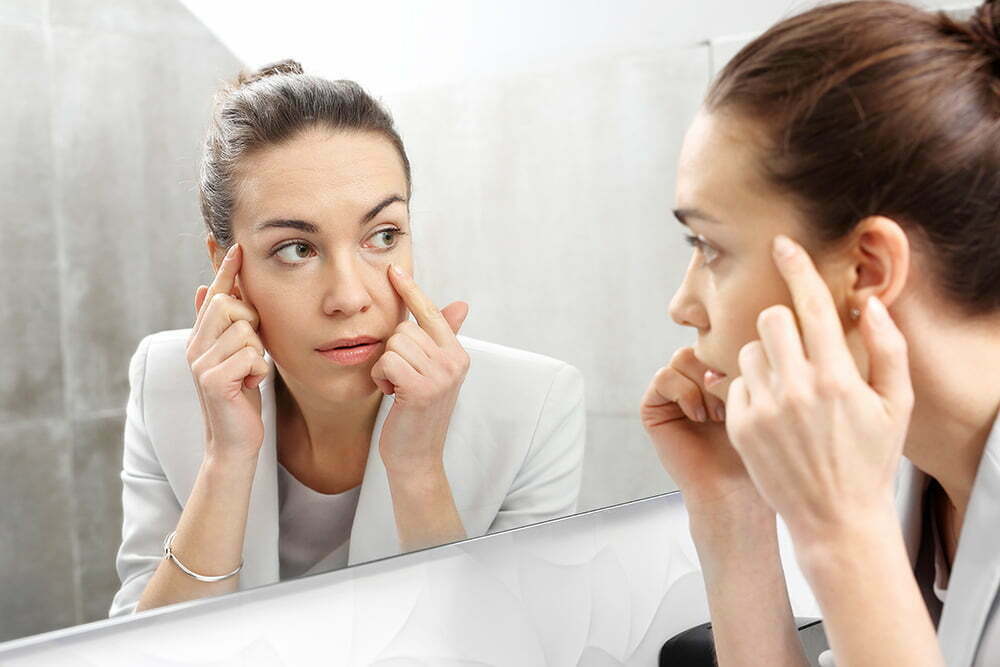Bags, Circles, & Swelling, Oh My! Understanding Your Under-Eye Woes (and How to Treat Them)

Do you ever look in the mirror and wonder if your eyes are puffy from all the pollen in the air or if you’ve suddenly inherited your dads baggy eyes? You’re not alone.
From sleep deprivation to our genetics, our eyes change both day to day and in the long term. And some problems will solve themselves, others require some intervention. Self recently addressed common eye appearance concerns, why they exist, and what you can do about it.
If you have dark circles
The culprit: genetics, skin tone, & lifestyle
Having dark circles underneath your eyes is fairly normal. People with fair skin, very little subcutaneous fat, or those who have high levels of venous congestion from a lack of sleep are even more likely to notice this issue. Allergies can be another cause. If you’re bothered by dark circles, there are options.
Possible solutions:
For those not getting enough sleep: you know what to do! Carve out some time to catch some extra zzz’s and drink plenty of water to keep your skin plump and hydrated. If you’re well rested and suspect allergies, make a diary of when you notice dark circles to see if you can track down the cause.
For those who have thin, fair skin: try a prescription retinoid cream which will encourage cell turnover and can even thicken the skin. Another option is choosing a medical-grade cream containing hyaluronic acid to stimulate collagen and elastin production. Just be sure whatever you choose is safe for use near the eyes—and you avoid getting too close to the edge of your eye when applying creams.
The culprit: facial anatomy
Sometimes darkness underneath the eyes comes from your facial shape. Having a prominent “tear trough” or the groove that goes from the inner corner of your eye to your cheekbone can cause shadowing that makes dark circles more noticeable. And what’s more, it can deepen with weight loss.
Possible solutions:
While there is not much you can do to change your facial anatomy, you can reduce the intensity of a pronounced tear trough with dermal fillers. This will add volume to the sunken area using hyaluronic acid, a naturally occurring substance in our bodies. It’s a quick treatment and lasts about a year; just be sure to choose a very experienced provider given the sensitivity of the area. Many practices use nurse injectors, but it’s safest to go with an MD (here at our practice, Dr. Garazo personally performs all injections).
If you have puffy, swollen eyes or bags under the eyes
The culprit: lifestyle
Typically, if you have puffy eyes you can thank your seasonal allergies. Additionally, if you’ve had too much salt or alcohol, you could be dehydrated which can lead to facial swelling. You’ll most likely notice this first thing in the morning, and it will reduce throughout the day as the accumulated fluid drains.
Possible solutions:
Hydrate, hydrate, hydrate! Also, consider adding a skincare product containing hyaluronic acid into your daily routine; this can help keep your skin healthy and happy no matter your situation that particular day.
As for allergies, talk to your doctor or local pharmacist about the best antihistamine for you. Another option is acupuncture; randomized controlled trials have shown acupuncture’s efficacy in treating allergic rhinitis, and the sinuses and eyes are connected.
The culprit: genetics and aging
If you have structural puffiness that does not go away over time (aka bags), it could be the process of aging and gravity. Over time our skin begins to loosen, sag, and fatty deposits can develop above and below the eyelids. This can make you appear tired, older than you are, and even impair your vision.
Possible solutions:
Many high-end eye creams imply they can help with visible sagging under the eyes, but the truth is only surgical intervention can remove excess skin and thus restore a more smooth appearance. The best way to eliminate sagging, whether it’s the upper or lower eyelids, is with blepharoplasty. The good news is that the procedure has a relatively easy recovery and patients enjoy a more alert, youthful appearance for years to come.
Learn more about your options
The best way to determine if you are a good candidate for eyelid surgery (or if non-surgical options are best suited to your concerns) is to consult with a board certified plastic surgeon. Dr. Garazo has helped many Hagerstown patients improve their eye appearance and confidence using a customized approach to fit their unique needs.
Contact us today for a consultation to see what we can do for you!
Leave a Comment
